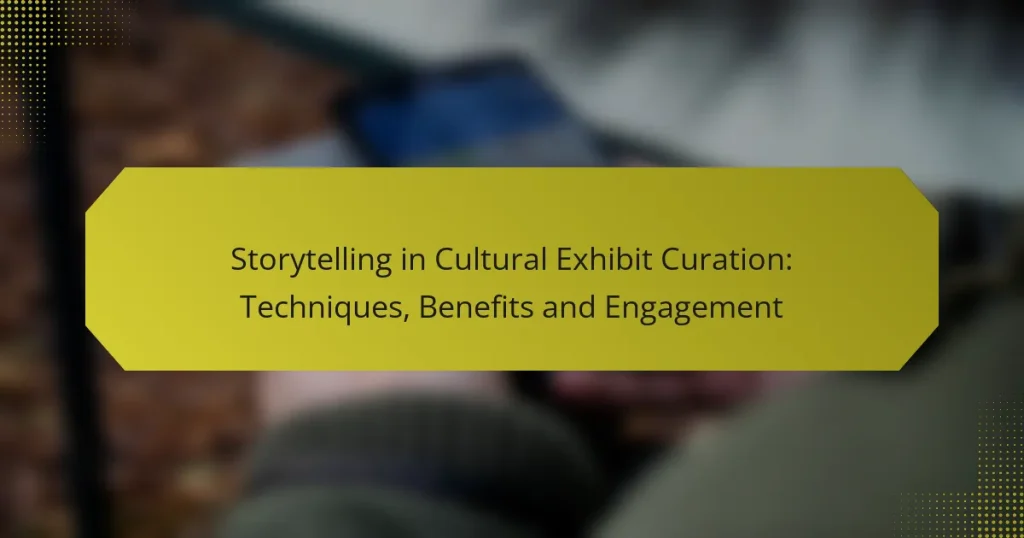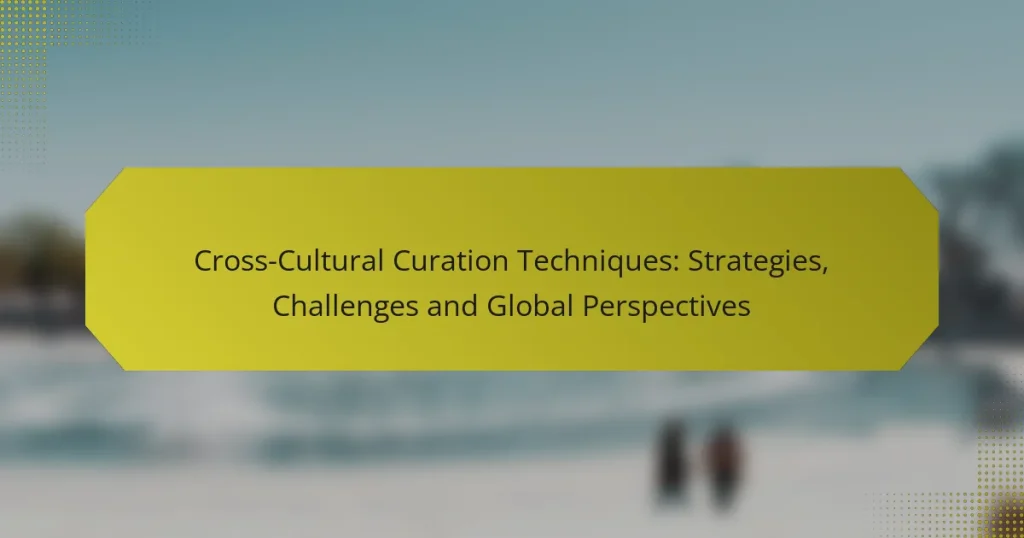Curatorial practices and methodologies play a crucial role in the development of engaging and informative exhibits. By strategically planning and considering audience needs, curators can create accessible experiences that resonate with diverse visitors. A well-defined methodology not only guides the selection of works but also ensures coherence and engagement throughout the exhibition process.
Storytelling in Cultural Exhibit Curation: Techniques, Benefits and Engagement
Curatorial Choices: Impact on Visitor Experience and Engagement
Traditional vs. Contemporary Curation Methods: Key Differences and Applications
Thematic Framework Development: Structure, Relevance and Audience Connection
Data Analytics in Curatorial Decisions: Insights, Tools and Applications
Cross-Cultural Curation Techniques: Strategies, Challenges and Global Perspectives
What are effective curatorial practices for exhibits?
Effective curatorial practices for exhibits involve strategic planning, audience consideration, and innovative presentation methods. These practices ensure that exhibitions are engaging, informative, and accessible to diverse audiences.
Audience engagement strategies
Audience engagement strategies focus on creating meaningful interactions between visitors and the exhibit. Techniques such as interactive displays, guided tours, and hands-on activities can enhance visitor experience and retention of information.
Consider using surveys or feedback forms to gather insights on visitor preferences and experiences. Tailoring content to meet audience interests can significantly increase engagement levels.
Collaborative curation methods
Collaborative curation methods involve working with artists, community members, and other stakeholders to develop exhibits. This approach fosters a sense of ownership and can lead to more diverse and representative content.
Establishing partnerships with local organizations or educational institutions can provide additional resources and expertise. Regular meetings and open communication are essential to ensure all voices are heard throughout the curation process.
Interactive exhibit design
Interactive exhibit design encourages visitor participation and exploration. Incorporating technology, such as augmented reality or touch screens, can create immersive experiences that captivate audiences.
Design elements should facilitate easy navigation and allow visitors to engage at their own pace. Consider using clear signage and intuitive layouts to enhance the interactive experience.
Community involvement techniques
Community involvement techniques aim to integrate local perspectives and narratives into exhibits. Hosting workshops or focus groups can help gather community input and foster a sense of belonging among local audiences.
Engaging local artists or historians can enrich the content and authenticity of the exhibit. Highlighting community stories can create a deeper connection between the exhibit and its visitors.
Digital curation tools
Digital curation tools streamline the process of organizing and presenting exhibit content. Platforms like Content Management Systems (CMS) or digital asset management software can help curators efficiently manage multimedia resources.
Utilizing social media and virtual tours can expand the reach of an exhibit beyond physical boundaries. Consider investing in user-friendly tools that allow for easy updates and audience interaction online.
How to choose a curatorial methodology?
Choosing a curatorial methodology involves evaluating the goals of the exhibit, the nature of the collection, and the audience’s needs. A well-defined methodology guides the selection process, ensuring that the exhibit is coherent and engaging.
Research-based selection
Research-based selection focuses on gathering and analyzing information relevant to the exhibit’s theme and objectives. This involves studying existing literature, previous exhibits, and current trends in the field. By grounding the methodology in thorough research, curators can create a more informed and impactful exhibit.
Consider utilizing academic journals, museum archives, and interviews with experts to enrich the selection process. This approach not only enhances the exhibit’s credibility but also helps in identifying unique narratives that resonate with the audience.
Contextual relevance assessment
Contextual relevance assessment evaluates how well the exhibit aligns with the cultural, historical, and social contexts of the artworks or artifacts being displayed. This step is crucial for ensuring that the exhibit speaks to contemporary issues or historical significance that may engage the audience more deeply.
To conduct this assessment, consider the local community’s values and interests, as well as current events that may influence public perception. This can help in tailoring the exhibit to foster meaningful connections and discussions among visitors.
Audience demographic analysis
Audience demographic analysis involves understanding the characteristics of the target audience, including age, education level, cultural background, and interests. This information is vital for curators to tailor the exhibit’s content and presentation style to meet the audience’s expectations.
Utilize surveys, visitor data, and community feedback to gather insights about potential visitors. This analysis can guide decisions on how to present information, which themes to emphasize, and what types of programming may enhance visitor engagement. Aim for inclusivity to attract a diverse audience and foster a richer experience.
What are the key components of exhibit planning?
Exhibit planning involves several critical components that ensure a successful presentation. These include theme development, budgeting, space considerations, and establishing a timeline, all of which work together to create an engaging visitor experience.
Theme development
Theme development is the foundation of any exhibit, guiding the narrative and design choices. A strong theme should resonate with the target audience and align with the institution’s mission. Consider brainstorming sessions with stakeholders to generate ideas and refine the concept.
Once a theme is selected, it’s essential to create a cohesive story that connects the exhibits. This can involve selecting artifacts, artworks, or multimedia elements that support the theme and enhance visitor engagement.
Budgeting and funding sources
Budgeting is a crucial step in exhibit planning, as it determines the scope and scale of the project. Start by estimating costs for materials, installation, marketing, and staffing. Aim for a budget that allows for flexibility, as unexpected expenses can arise.
Identifying funding sources is equally important. Explore grants, sponsorships, and partnerships with local businesses or organizations. Consider applying for government or private funding that aligns with your exhibit’s theme to enhance financial support.
Space and layout considerations
Space and layout are vital for creating an effective exhibit. Assess the available area to determine how to best utilize it for flow and accessibility. Consider visitor movement patterns and ensure that the layout allows for easy navigation.
Incorporate elements such as signage, lighting, and interactive displays to enhance the visitor experience. A well-planned layout can significantly impact how visitors engage with the exhibit and retain information.
Timeline establishment
Establishing a timeline is essential for keeping the exhibit planning process on track. Begin by setting a clear opening date and work backward to outline key milestones, such as theme finalization, artifact selection, and installation deadlines.
Regularly review and adjust the timeline as needed to accommodate any changes or delays. Effective communication with all team members will help ensure that everyone is aligned and aware of their responsibilities throughout the planning process.
What are the challenges in curatorial practices?
Curatorial practices face several challenges that can impact the success of an exhibit. Key issues include resource limitations, stakeholder management, and the need to balance artistic vision with audience expectations.
Resource limitations
Resource limitations often hinder curatorial practices, affecting budget, time, and personnel. Many curators work with tight budgets that restrict the scope of their projects, leading to compromises in exhibition quality or content.
To navigate these constraints, curators should prioritize essential elements of the exhibit and seek alternative funding sources, such as grants or sponsorships. Collaborating with local artists and institutions can also help maximize resources.
Stakeholder management
Effective stakeholder management is crucial in curatorial practices, as curators must balance the interests of various parties, including artists, sponsors, and the public. Each stakeholder may have different expectations and demands that can complicate decision-making.
Establishing clear communication channels and setting realistic expectations from the outset can help mitigate conflicts. Regular updates and feedback sessions with stakeholders can foster collaboration and ensure that everyone remains aligned with the exhibit’s goals.
Balancing artistic vision and audience expectations
Balancing artistic vision with audience expectations is a common challenge for curators. While curators aim to present innovative and thought-provoking work, they must also consider what will engage and attract visitors.
To achieve this balance, curators can conduct audience research to understand preferences and interests. Incorporating interactive elements or educational programming can also enhance visitor engagement without compromising the artistic intent of the exhibit.
How to evaluate the success of an exhibit?
Evaluating the success of an exhibit involves assessing visitor satisfaction, engagement levels, and overall impact. Key metrics include visitor feedback, engagement metrics, and post-exhibit surveys to gather comprehensive insights.
Visitor feedback collection
Collecting visitor feedback is essential for understanding their experiences and perceptions of the exhibit. This can be done through comment cards, digital surveys, or informal conversations during and after the visit.
Consider using open-ended questions to capture detailed responses, alongside rating scales for quantitative analysis. Aim for a response rate of at least 10-20% of total visitors to ensure a representative sample.
Engagement metrics analysis
Engagement metrics provide quantitative data on how visitors interact with the exhibit. Key indicators include time spent at the exhibit, number of visitors, and social media interactions related to the exhibit.
Utilize tools like foot traffic counters and social media analytics to gather this data. Aiming for a dwell time of several minutes can indicate a higher level of engagement, while low interaction rates may suggest areas for improvement.
Post-exhibit surveys
Post-exhibit surveys are a valuable tool for gathering insights after visitors have left the exhibit. These surveys can assess overall satisfaction, learning outcomes, and suggestions for future improvements.
Distributing surveys via email or social media can increase participation. Offering a small incentive, such as a discount on future visits, can also encourage responses and improve your data collection efforts.






